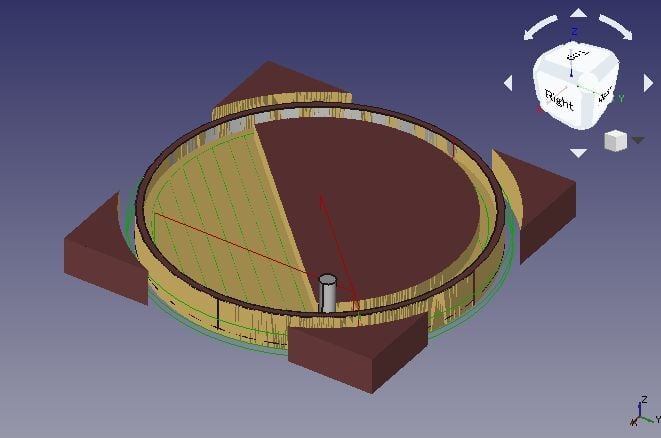
Each constructed building forms interconnections with its surrounding environment. The fundamental design process for architects requires knowledge of temperature, wind patterns, solar radiation, and humidity conditions at a site to create buildings with the desired abilities. This process—climate site analysis architecture—is a core part of early project planning.
Environmental site analysis architecture enables architects to develop site-specific design choices through their work. A comprehensive analysis of climate conditions enables architects to select appropriate design decisions from a practical standpoint, which results in informed decisions derived from data-based findings.
This article explains climate analysis fundamentals, demonstrates its importance, and presents methods and tools needed to perform the analysis along with structured workflow guidelines. The site analysis categories you need to cover for your architecture thesis project serve as a beneficial additional source for students conducting academic projects.
What is Climate Analysis in Architecture?
The process of climate site analysis architecture requires studying the extended weather patterns experienced by specific areas. Design-related choices such as building orientation, shading solutions, ventilation methods, insulation practices, and materials depend on these data. Efficient building operation in their environmental context aims to achieve buildings that work well for both comfort and performance requirements.
Architectural site analysis comprises climate evaluation as one subdiscipline, along with the investigation of topography, vegetation, access pathways, and cultural elements. Climate data is an essential factor determining the development of passive design strategies.
The Importance of site analysis in architecture is that when designs operate across various climatic zones, including hot-arid, composite, humid, and cold regions, these environments demand distinct approaches to form and structure. Novatr provides an example guide on 8 Best Passive Design Strategies for Warm and Humid Climate that demonstrates climate-responsive solutions.
Key Climatic Factors Architects Must Study
Image: Source
Caption: An image showing a world map classifying arid climate zones as per UNEP climate data.
When conducting a site analysis architecture, it’s crucial to focus on climatic variables influencing energy use and occupant comfort. Key factors include
1. Temperature Range
Analyzing temperature variations throughout the year helps establish required insulation measures, thermal density positions, and heating, ventilation, and air conditioning (HVAC) systems.
2. Solar Radiation and Sun Path
Proper positioning of openings, photovoltaic panels, and shading devices is made possible by understanding sun movements across the site. Architecture site analysis diagrams, known as sun path charts, exist as significant tools for architectural site investigations.
3. Wind Patterns
Site analysis of prevailing wind patterns allows architects to determine better, more appropriate locations for doors, windows, and courtyards. Passive cooling architecture gets help from wind data to provide cross ventilation as an effective cooling method.
4. Humidity Levels
Inspected moisture content in the air may reduce building material longevity and degrade the internal environment quality. Climate analysis helps architects choose appropriate materials and develop ventilation methods.
5. Rainfall and Stormwater
Observing precipitation helps architects design roofs together with drainage elements and harvest water.
6. Microclimates
Layout design and zoning distribution require accurate identification of microclimate variations caused by vegetation, built structures, and water bodies.
The local climate shapes energy efficiency approaches because it enables the implementation of passive cooling architecture systems. Novatr’s blog on Passive Design Strategies for Building in a Hot and Dry Climate provides valuable region-specific design tactics if you're working in arid zones.
Techniques Used for Conducting Climate Analysis

Climate analysis combines observational data with digital tools and interpretive methods. The following steps are common in both academic and professional workflows:
1. Gather Historical Climate Data
Sources like meteorological databases, government records, and open-source platforms provide reliable temperature, wind, humidity, and solar radiation datasets.
2. Use Diagrams for Visualization
Creating architecture site analysis diagrams like wind roses, sun path charts, and psychrometric charts helps synthesize complex data into visual formats.
3. Site Observation and Recording
Visiting the site to document wind movement, sun exposure, and shadow patterns allows for more context-aware analysis.
4. Evaluate Passive Design Potential
Match the climate data with passive strategies such as natural ventilation, thermal mass placement, or solar shading. This step bridges site analysis landscape architecture with climate-responsive design.
5. Integrate Data Into the Design
Apply findings directly to orientation, layout, and building envelope decisions. For instance, a building in a hot-dry climate might prioritize thick walls and shaded courtyards.
Evaluating passive design potential also helps bridge site analysis landscape architecture with actual building performance. Using architecture site analysis diagrams like sun path and wind rose charts strengthens visual communication in academic and client-facing presentations.
Tools & Software for Climate Analysis
Conducting accurate, efficient climate analysis becomes easier through multiple digital tools.
1. Climate Consultant
UCLA developed Climate Consultant into a free platform that transforms EnergyPlus climate data into visual charts and psychrometric analysis for designing passive strategies.
2. Ladybug Tools (for Rhino/Grasshopper)
The Rhino application benefits from a robust plug-in designed to show and analyze climate information inside the Rhino environment. This tool has gained wide use in parametric workflows because it provides real-time feedback and supports environmental site analysis architecture.
3. Autodesk Insight
Through its Insight feature, the platform combines BIM software Revit with energy and climate analysis capabilities. Users apply this tool to estimate building energy usage and assess heating and ventilation requirements using local weather conditions.
4. Meteonorm
The data collection includes observations from thousands of weather stations worldwide to deliver precise reports about particular locations.
5. DesignBuilder
DesignBuilder performs state-of-the-art simulations evaluating design elements related to energy use, lighting conditions, and climate requirements. DesignBuilder serves professionals who perform studies to obtain sustainability certifications in their practice.
These architectural simulation tools enable professionals to change belief-based decisions with data-driven understanding, resulting in building solutions that conserve resources and protect the environment.
Autodesk Insight's BIM-integrated tool lets users run performance simulation models to analyze different scenarios while implementing climate zone data.
Conclusion
Building projects without climate analysis resemble construction activities in the dark. Understanding climate data creates better comfort for building users, minimizes power consumption, and supports extended building sustainability. Property designers obtain environmentally friendly building creation skills through climate site analysis architecture.
Accurate environmental site analysis architecture processes have acquired increasing worth because energy efficiency has become a primary global concern as climate patterns transform. All vital design elements benefit from analysis of sun paths while studying wind flows and temperature data, resulting in stronger thermal performance solutions and passive ventilation capabilities.
A BIM Professional Course for Architects delivered by Novatr enables architects to use this information effectively through design documentation and modeling processes. The training program includes analysis of integral site operations, sustainable development application modules, and advanced BIM platform solutions.
A better understanding of connecting climate conditions with design plans can be obtained through Passive Design Strategies for Composite Climate, which serves architects who operate in diverse climate conditions.
You can access Novatr's Resource Page for tools and programs that help architectural and engineering professionals and construction experts.
Was this content helpful to you



.jpg)




.png)

